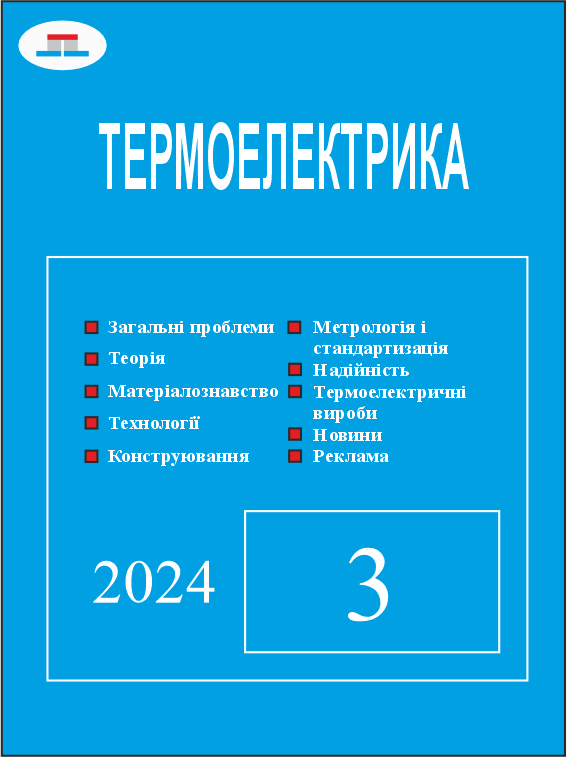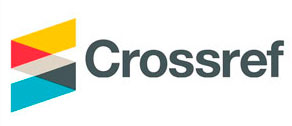Моделювання характеристик термоелектричного перетворювача
Лекція на Літній Термоелектричній школі, 30 червня, 2024, Краків, Польща
DOI:
https://doi.org/10.63527/1607-8829-2024-3-5-22Ключові слова:
термоелектричний перетворювач, енергоефективність термоелектричного модуля, методи теорії оптимального керування, холодильний коефіцієнт, електричний контактний опір, термічний опір комутаційних та ізоляційних пластинАнотація
За приблизними підрахунками річне світове виробництво термоелектричних перетворювачів (модулів) для потреб термоелектричної генерації та охолодження досягає понад 50 мільйонів штук. Термоелектричні перетворювачі механічно стійкі, високонадійні з терміном служби до 20 років. Головним недоліком є їх низька енергоефективність. Особливо це стосується мініатюрних модулів з довжиною термоелементів від 500 мкм до 200 мкм. Їх низька енергоефективність обумовлена дією електричних і теплових опорів контактів, комутацій та ізоляційних пластин. Одним із шляхів підвищення ефективності термоелектричних генераторів і охолоджувачів є оптимізація матеріалів та конструкції термоелектричних модулів для необхідних умов експлуатації. Для цього доцільно використовувати методи теорії оптимального керування. Вони придатні для оптимізації одно- і багатокаскадних перетворювачів, виготовлених з однорідних або неоднорідних, так званих функціонально градієнтних термоелектричних матеріалів (ФГТМ). Методи оптимального керування дозволяють враховувати температурні залежності термоелектричних параметрів матеріалів, додаткові об’ємні термоелектричні ефекти, яків виникають в ФГТМ, та вплив небажаних електричних і теплових опорів у модулях. У цій лекції висвітлюються основні поняття теорії оптимального керування та пояснюється, як вони використовуються для проєктування оптимальної конструкції модулів та моделювання їх характеристик. Розглянуто приклади розрахунку характеристик перетворювачів та проаналізовано вплив небажаних електричних і теплових опорів на максимальну енергетичну ефективність охолоджуючих і генераторних перетворювачів з матеріалів на основі Bi2Te3. Показано, що ефективність модулів, особливо мініатюрних, можна значно підвищити, якщо ці небажані опори зменшити до раціональних значень. Переважаючим фактором є зниження електричного контактного опору. Визначено раціональні значення, до яких доцільно зменшити цей опір. Саме на такі раціональні значення контактного опору необхідно орієнтуватися в розробці технології модулів.
Under the rough estimation the annual worldwide production of thermoelectric converters (modules) for the needs of thermoelectric power generation and cooling reaches more than 50 million pieces. The thermoelectric convertors are mechanically stable, high-reliable with a life cycle up to 20 years. The main disadvantage is their low energy efficiency. This especially applies to miniature modules with a length of thermoelements in the range from 500 mm down to 200 mm. Their low efficiency is due to the effect of electrical and thermal resistances of contacts, interconnectors and insulating plates. One way to improve the efficiency of thermoelectric generators and coolers is to optimize the materials and structure of thermoelectric modules for the required operating conditions. For this purpose, it is advisable to use methods of optimal control theory. They are suitable for optimizing single- and multi-stage converters made of homogeneous or inhomogeneous, so-called functionally graded thermoelectric materials (FGTM). The optimal control method makes it possible to take into consideration the temperature dependences of the thermoelectric parameters of materials, additional bulk thermoelectric effects that occur in FGTMs, and the influence of unwanted electrical and thermal resistances in modules. This lecture outlines the main concepts of the optimal control theory and explains how to use them to design modules with optimal structure and simulate module characteristics. Examples of modeling the convertor performances are considered and the effect of undesirable electrical and thermal resistances on the maximum efficiency of cooling and generating converters made of Bi2Te3-based materials is analyzed. It is shown that the efficiency of modules, especially of miniature ones, can be significantly improved if these unwanted resistances are reduced to their rational values. The decrease in electrical contact resistance is the predominant factor. The rational values to which it is advisable to decrease the electrical contact resistivity have been determined. It is necessary to focus on such rational contact resistance values in the development of modules’ technology. Bibl. 9, Figs. 9, Tabl. 2.
Посилання
1. Salah, W.A., Abuhelwa, M. (2020). Review of thermoelectric cooling devices recent applications. J Eng Sci Technol 15(1), 455–76.
2. Dunham, M.T., Barako, M.T., LeBlanc, S., Asheghi-Roudheni, M., Chen, B., Goodson, K. (2013). Modeling and optimization of small thermoelectric generators for low-power electronics. In Proceedings of the ASME 2013 International Technical Conference and Exhibition on Packaging and Integration of Electronic and Photonic Microsystems. Volume 1: Burlingame, California, USA. July 16–18, 2013.
3. Scott, A., Whalen, C. A., Apblett, T. L. (2008). Improving power density and efficiency of miniature radioisotopic thermoelectric generators, J Power Sources, 180, 657-663.
4. Qian Xu, Biao Deng, Lenan Zhang, Shaoting Lin, et al. (2022). High-performance, flexible thermoelectric generator based on bulk materials, Cell Reports Physical Science, 3(3), 100780.
5. Vikhor, L., Kotsur, M. (2023). Evaluation of efficiency for miniscale thermoelectric converter under the influence of electrical and thermal resistance of contacts. Energies, 16, 4082.
6. Ioffe, A.F. (1957). Semiconductor thermoelements and thermoelectric cooling; Infosearch Limited: London, UK, 184 pp.
7. Anatychuk, L.I. (2003). Thermoelectricity. Volume 2. Thermoelectric energy convertors. Institute of Thermoelectricity: Chernivtsi, Ukraine, 348 pp.
8. Anatychuk, L. I. and Vikhor, L. N. (2012). Thermoelectricity. Volume IV. Functionally graded thermoelectric materials. Institute of Thermoelectricity, Chernivtsi, Ukraine, 172 pp.
9. He, H., Wu, Y., Liu,W., Rong, M., Fang, Z., Tang, X. (2019). Comprehensive modeling for geometric optimization of a thermoelectric generator module. Energy Convers. Manag. 183, 645–659.




